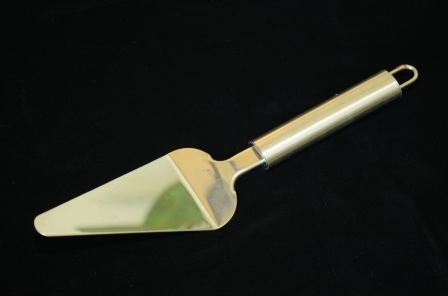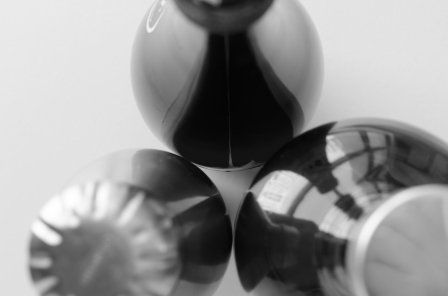Shiny Surfaces
Highly reflective surfaces can be a challenge to light and this exercise looks at one method of doing so.
The instructions ask that I gather an object so shiny that I can see my face in it and some large sheets of tracing paper. I selected a metal cake slice and placed it on the floor with the camera fitted to a tripod above it and pointing downwards. I fitted my Speedlight to the camera, set it to 1/16 power and then took a photograph.
The metal is very brightly lit with large areas of white where the flashlight has reflected off of the metal. There is also an area of green, the reflection of a plant that was sitting nearby. The metal is bright because direct reflections area mirror image of the light source that produces them (Hunter et al , 2012, p38).
For the next shot the tracing paper came into play, or in this case, baking parchment that I had at home. I was asked to form the paper into a cone shape where the small end would cover the lens of the camera and the wide end would t around the subject without being seen by the camera. This was an extremely fiddly task. As the baking parchment was in a roll I had to fix several strips together to make one large piece of paper. Sticky tape, somewhat ironically, didn’t stick so I then tried glue stick, which seemed to do the trick. After several attempts I managed to get the paper into a cone shape and fit it over my lens, holding it in place with an elastic band. The ‘cone’ wouldn’t keep its shape and requires several adjustments to keep it out of the viewfinder. I kept the Speedlight on my camera but positioned on the exterior of the paper cone. I then took the shot.
The bright, white reflections are gone and now the metal appears grey. This is because firing the flash through the baking parchment has sufficiently diffused the light, softening it and eliminating the glare.
The bright, white reflections are gone and now the metal appears grey. This is because firing the flash through the baking parchment has sufficiently diffused the light, softening it and eliminating the glare.
However had the metal object I had chosen as a subject had a rounded shape, such as a kettle, this technique may not have eliminated all reflections and may even have reflected the camera in the metal. Hunter et al (20012, p148) notes that when lighting a round piece of metal the family of angles consists of almost the whole environment. This causes everything to be reflected, camera included. The almost 360 degree family of angles can be seen in the shot below.
Hunter et al (2012, p148) suggest three ways to eliminate the camera reflection when photographing metal. They are to camouflage it with texture or additional subjects in the scene, which is what I think has happened in the shot above. To keep the light off the camera by covering it in black material of using a long lens and alternatively, by using a light tent.
This exercise has been useful in introducing me to some ways that it might be possible to successfully light metal. However, it would seem before embarking on lighting sets ups it would be wise to consider if I want the metal bright, dark or a combination of both, which Hunter et al (2012, 131) describe as the elegant compromise.
Hunter, F., Biver, S. and Fuqua, P. (2012) Light- Science and Magic. (4th Ed.) Waltham: Focal Press


